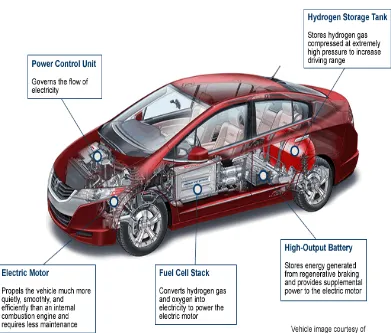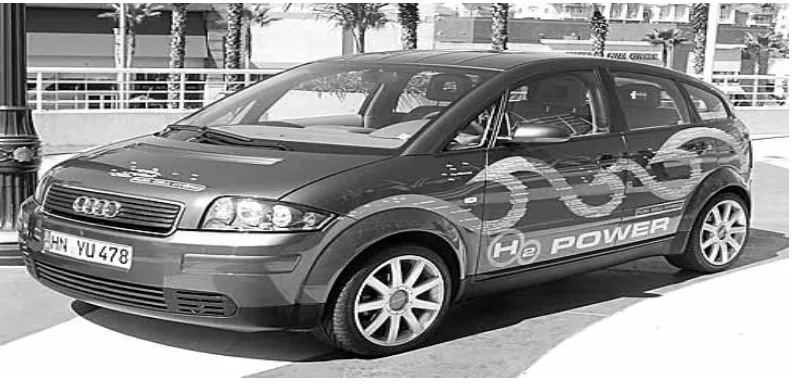ANALYSIS THE FUTURE APPLICATION OF RENEWABLE ENERGY ON VEHICLE
ABU BAKAR @ AS-SIDDIQ BIN AHMAD
This report is submitted as partial fulfillment of requirements for the award Bachelor of Mechanical
Engineering (Automotive)
Faculty of Mechanical Engineering Universiti Teknikal Malaysia Melaka
‘I admit that had read this thesis and in my opinion this thesis was satisfied from the aspect of scope and quality for the purpose to be awarded
Bachelor of Mechanical Engineering (Automotive)’
Signature : ... Name of Supervisor I : ... Date : ...
CONFESSION
“I verify that this report is my own work except for the citation and quotation that the source has been clarified for each one of them”
Signature : ………..
Name of Author : ………..
To my beloved parents, My siblings
And also
ACKNOWLEDGEMENT
First and foremost, we would like to thank to my supervisor of this project, Dr Musthaphah Bin Tahir for the valuable guidance and advice. He inspired me greatly to work in this project. His willingness to motivate me contributed tremendously to my project. We also would like to thank him for showing me some example that related to the topic of our project.
Besides, I would like to thank the authority of University Technical Malaysia Malacca for providing me with a good environment and facilities to complete this project. Also, I would like to take this opportunity to thank to the Mechanical Engineering Department of University Technical Malaysia Malacca for offering this subject, Projek Sarjana Muda (PSM). Based on my title of PSM, future application of renewable energy on vehicle, it gave me an opportunity to participate and learn about the operation of vehicle without using fuel as such as Electric Vehicle and Fuel Cell Vehicle.
ABSTRACT
ABSTRAK
TABLE OF CONTENT
CHAPTER TITLE
PAGE
DECLARATION ii
CONFESSION iii
DEDICATION iv
ACKNOWLEDGEMENT v
ABSTRACT vi
ABSTRAK vii
TABLE OF CONTENT viii
LIST OF FIGURE xii
LIST OF TABLES xv
LIST OF SYMBOLS xvi
1 INTRODUCTION
4.3.5 Flow of Regenerative Braking on 74
Bicycle
4 CONCLUSION
5.1 Electric Vehicle and Fuel Cell Vehicle 76 5.2 Regenerative Braking 77
5.3 Recommendation 78
REFERENCES 79
APPENDICES 83
LIST OF FIGURE
BIL
TITLE
PAGE
1 Fuel Cell Vehicle System Diagram
5
2 Present Fuel Cell Vehicle 6
3 Diagram For Electric Vehicle System 7
4 Present Electric Vehicle 12
5 Regenerative Braking Diagram 15
6 Well-to-Wheel for EV 22
7 Well-to-Wheel for FCV 22
8 Energy Flow Diagram for EV and FCV 26
9 Natural Gas Required 26
10 Hydrogen FCV propulsion systems 30
11 Battery Cooling Modes 34
13 Regenerative Braking Force versus Acceleration 37 14 Control logic of brake forces of front and rear wheels 39 15 Control logic of brake force distribution to regenerative and 39
33 Electric Bicycle after Installment 69
34 Controller 69
35 Brake Lever 70
36 Regulator Throttle 71
37 26 inch Wheel with Motor 72
LIST OF TABLES
BIL
TITLE
PAGE
1 Table Comparison 62
2 Advantaged FCV and EV 65
3 Disadvantages FCV and EV 66
LIST OF SYMBOL AND ABBREVATION AND NOMENCLATURE
EV = Electric Vehicle FCV = Fuel Cell Vehicle POPA = Panel on Public Affairs CO2 = Carbon Dioxide
ICE = Internal Combustion Engine CO = Carbon Monoxide
HC = Hydro Carbon
NEDC = National Engineering Design Challenge LCA = Life Cycle Assessment
PEM = Polymer Electrolyte Membrane CNG = Compressed Natural Gas H2 = Hydrogen
NO2 = Nitrogen Oxide
O2 = Oxygen
H2O = Hydrogen Oxide (water)
SLI = Starting Lighting Ignition
CHAPTER 1
INTRODUCTION
1.1 FUEL CELL VEHICLE
A Fuel cell vehicle or FC vehicle (FCV) is a type of hydrogen vehicle which uses a fuel cell to produce its on-board motive power. Fuel cells create electricity to power an electric motor using hydrogen or a reformed hydrocarbon fuel and oxygen from the air.
At the beginning of 2002, the World Administration announced the FreedomCAR initiative, an industry-government cooperative effort, to develop fuel cell vehicles. This prompted a subcommittee of the POPA Energy and Environment Committee to commence work on a report about fuel cells and Freedom CAR. The rationale for preparing such a report is that the topic is an important aspect of the nation’s energy policy’s topic that physicists justifiably feel competent to discuss.
materials aspects of fuel cells are especially inside the view of physicists. Overall systems considerations, wells-to-wheels energy efficiency, and related issues can benefit from analysis by physicists. In view of the high expectations for fuel-cell vehicles generated by the Freedom CAR initiative, it seems reasonable to examine what is reality and what is unsupported optimism.
The motivation for the fuel cell vehicle initiative is to reduce dependence on imported petroleum, to reduce emissions of atmospheric pollutants, and to reduce CO2 emissions by improving fuel economy and/or by going to a
hydrogen-based system. Since the transportation sector itself uses more oil than produced domestically. Fuel Cell vehicle also addresses a serious national security issue.
Fuel cell vehicle has the following technology-specific goals for 2010:
• To ensure reliable systems with costs comparable with conventional internal combustion engine/automatic transmission systems, future fuel cell power trains should have Electric propulsion system with a 15-year life capable of delivering at least 55 kW for 18 seconds and 30 kW in a continuous mode, at a system cost of $12/kW peak. [Note this pertains to electrical systems other than the fuel cell such as electric motors, controllers, etc.]
• A durable fuel cell power system (including hydrogen storage) that achieves 60%energy efficiency when operating at peak power and that offers a 325 W/kg power density and 220 W/L operating on hydrogen. Cost targets are $45/kW by 2010, $30/kW by 2015.
systems, including a fuel reformer, that have a peak energy efficiency of 45% and meet or exceed emissions standards with a cost target of $45/kW by 2010 and $30/kW in 2015.
To enable the transition to a hydrogen economy, ensure widespread availability of hydrogen fuels, and retain the functional characteristics of current vehicles, the goals are
• Demonstrated hydrogen refueling with developed commercial codes and standards and diverse renewable and non-renewable energy sources. Targets: 70% energy efficiency well-to-pump; cost of energy from hydrogen equivalent to gasoline at market price, assumed to be $1.25 per gallon (2001 dollars).
Technical goals are not yet available, but the general goals are:
• Lowering the cost of hydrogen: Currently, hydrogen is four times as expensive to produce as gasoline (when produced from its most affordable source, natural gas). The Fuel cell vehicle and Fuel Initiative seeks to lower that cost enough to make fuel cell cars cost-competitive with conventional gasoline-powered vehicles by 2010; and to advance the methods of producing hydrogen from renewable resources, nuclear energy, and even coal.
• Creating effective hydrogen storage: Current hydrogen storage systems are inadequate for use in the wide range of vehicles that consumers demand.
Audi A2H2
HONDA FCX
1.2 ELECTRIC VEHICLE
An electric vehicle (EV), also referred to as an electric drive vehicle, uses one or more electric motors for propulsion. Electric vehicles include electric cars, electric trains, electric lorries, electric airplanes, electric boats, electric motorcycles and scooters, and electric spacecraft. Electric vehicles first came into existence in the mid-19th century, when electricity was among the preferred methods for automobile propulsion, providing a level of comfort and ease of operation that could not be achieved by the gasoline cars of the time. The internal combustion engine (ICE) is the dominant propulsion method for automobiles, but electric power has remained commonplace in other vehicle types, such as trains and smaller vehicles of all types.
During the last few decades, increased concern over the environmental impact of the petroleum-based transportation infrastructure, along with the spectra of peak oil, has lead to renewed interest in an electric transportation infrastructure. Electric vehicles differ from fossil fuel-powered vehicles in that the electricity they consume can be generated from a wide range of sources, including fossil fuels, nuclear power, and renewable sources such as tidal power, solar power, and wind power or any combination of those. However it is generated, this energy is then transmitted to the vehicle through use of overhead lines, wireless energy transfer such as inductive charging, or a direct connection through an electrical cable. The electricity may then be stored onboard the vehicle using a battery, flywheel, or super capacitors. Vehicles making use of engines working on the principle of combustion can usually only derive their energy from a single or a few sources, usually non-renewable fossil fuels.

